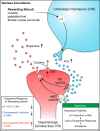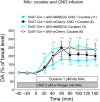p11 in Cholinergic Interneurons of the Nucleus Accumbens Is Essential for Dopamine Responses to Rewarding Stimuli
- PMID: 30417079
- PMCID: PMC6223111
- DOI: 10.1523/ENEURO.0332-18.2018
p11 in Cholinergic Interneurons of the Nucleus Accumbens Is Essential for Dopamine Responses to Rewarding Stimuli
Erratum in
-
Erratum: Hanada et al., p11 in Cholinergic Interneurons of the Nucleus Accumbens Is Essential for Dopamine Responses to Rewarding Stimuli (eNeuro September/October 2018, 5(5) e0332-18.2018 1-20 https://doi.org/10.1523/ENEURO.0332-18.2018).eNeuro. 2018 Dec 26;5(6):ENEURO.0493-18.2018. doi: 10.1523/ENEURO.0493-18.2018. eCollection 2018 Nov-Dec. eNeuro. 2018. PMID: 30627651 Free PMC article.
Abstract
A recent study showed that p11 expressed in cholinergic interneurons (CINs) of the nucleus accumbens (NAc) is a key regulator of depression-like behaviors. Dopaminergic neurons projecting to the NAc are responsible for reward-related behaviors, and their function is impaired in depression. The present study investigated the role of p11 in NAc CINs in dopamine responses to rewarding stimuli. The extracellular dopamine and acetylcholine (ACh) levels in the NAc were determined in freely moving male mice using in vivo microdialysis. Rewarding stimuli (cocaine, palatable food, and female mouse encounter) induced an increase in dopamine efflux in the NAc of wild-type (WT) mice. The dopamine responses were attenuated (cocaine) or abolished (food and female mouse encounter) in constitutive p11 knock-out (KO) mice. The dopamine response to cocaine was accompanied by an increase in ACh NAc efflux, whereas the attenuated dopamine response to cocaine in p11 KO mice was restored by activation of nicotinic or muscarinic ACh receptors in the NAc. Dopamine responses to rewarding stimuli and ACh release in the NAc were attenuated in mice with deletion of p11 from cholinergic neurons (ChAT-p11 cKO mice), whereas gene delivery of p11 to CINs restored the dopamine responses. Furthermore, chemogenetic studies revealed that p11 is required for activation of CINs in response to rewarding stimuli. Thus, p11 in NAc CINs plays a critical role in activating these neurons to mediate dopamine responses to rewarding stimuli. The dysregulation of mesolimbic dopamine system by dysfunction of p11 in NAc CINs may be involved in pathogenesis of depressive states.
Keywords: acetylcholine; anhedonia; cholinergic interneuron; dopamine; nucleus accumbens; p11.
Figures








Comment in
-
Potential Protein Target to Therapeutically Restore Positive Mood States in Depression.eNeuro. 2019 Mar 28;6(2):ENEURO.0105-19.2019. doi: 10.1523/ENEURO.0105-19.2019. eCollection 2019 Mar-Apr. eNeuro. 2019. PMID: 30937359 Free PMC article.
Similar articles
-
Cholinergic Interneurons Underlie Spontaneous Dopamine Release in Nucleus Accumbens.J Neurosci. 2017 Feb 22;37(8):2086-2096. doi: 10.1523/JNEUROSCI.3064-16.2017. Epub 2017 Jan 23. J Neurosci. 2017. PMID: 28115487 Free PMC article.
-
Striatal muscarinic receptors promote activity dependence of dopamine transmission via distinct receptor subtypes on cholinergic interneurons in ventral versus dorsal striatum.J Neurosci. 2010 Mar 3;30(9):3398-408. doi: 10.1523/JNEUROSCI.5620-09.2010. J Neurosci. 2010. PMID: 20203199 Free PMC article.
-
Distinctive Modulation of Dopamine Release in the Nucleus Accumbens Shell Mediated by Dopamine and Acetylcholine Receptors.J Neurosci. 2017 Nov 15;37(46):11166-11180. doi: 10.1523/JNEUROSCI.0596-17.2017. Epub 2017 Oct 13. J Neurosci. 2017. PMID: 29030431 Free PMC article.
-
[Depression and addiction comorbidity: towards a common molecular target?].Med Sci (Paris). 2015 May;31(5):546-50. doi: 10.1051/medsci/20153105017. Epub 2015 Jun 9. Med Sci (Paris). 2015. PMID: 26059306 Review. French.
-
Cholinergic modulation of mesolimbic dopamine function and reward.Physiol Behav. 2011 Jul 25;104(1):76-81. doi: 10.1016/j.physbeh.2011.04.052. Epub 2011 May 1. Physiol Behav. 2011. PMID: 21549724 Free PMC article. Review.
Cited by
-
The Nucleus Accumbens: A Common Target in the Comorbidity of Depression and Addiction.Front Neural Circuits. 2020 Jun 30;14:37. doi: 10.3389/fncir.2020.00037. eCollection 2020. Front Neural Circuits. 2020. PMID: 32694984 Free PMC article. Review.
-
Cholinergic interneurons in the nucleus accumbens are a site of cellular convergence for corticotropin-releasing factor and estrogen regulation in male and female mice.Eur J Neurosci. 2024 Sep;60(5):4937-4953. doi: 10.1111/ejn.16477. Epub 2024 Jul 30. Eur J Neurosci. 2024. PMID: 39080914 Free PMC article.
-
Projections from ventral hippocampus to nucleus accumbens' cholinergic neurons are altered in depression.J Gen Physiol. 2025 May 5;157(3):e202413693. doi: 10.1085/jgp.202413693. Epub 2025 Mar 7. J Gen Physiol. 2025. PMID: 40052940
-
Cholinergic Interneurons in the Accumbal Shell Region Regulate Binge Alcohol Self-Administration in Mice: An In Vivo Calcium Imaging Study.Brain Sci. 2024 May 10;14(5):484. doi: 10.3390/brainsci14050484. Brain Sci. 2024. PMID: 38790462 Free PMC article.
-
Distinct Role of Dopamine in the PFC and NAc During Exposure to Cocaine-Associated Cues.Int J Neuropsychopharmacol. 2021 Dec 8;24(12):988-1001. doi: 10.1093/ijnp/pyab067. Int J Neuropsychopharmacol. 2021. PMID: 34626116 Free PMC article.
References
-
- Alexander B, Warner-Schmidt J, Eriksson T, Tamminga C, Arango-Lievano M, Ghose S, Vernov M, Stavarache M, Musatov S, Flajolet M, Svenningsson P, Greengard P, Kaplitt MG (2010) Reversal of depressed behaviors in mice by p11 gene therapy in the nucleus accumbens. Sci Transl Med 2:54ra76. 10.1126/scitranslmed.3001079 - DOI - PMC - PubMed
-
- Arango-Lievano M, Schwarz JT, Vernov M, Wilkinson MB, Bradbury K, Feliz A, Marongiu R, Gelfand Y, Warner-Schmidt J, Nestler EJ, Greengard P, Russo SJ, Kaplitt MG (2014) Cell-type specific expression of p11 controls cocaine reward. Biol Psychiatry 76:794–801. 10.1016/j.biopsych.2014.02.012 - DOI - PMC - PubMed
-
- Berlanga ML, Olsen CM, Chen V, Ikegami A, Herring BE, Duvauchelle CL, Alcantara AA (2003) Cholinergic interneurons of the nucleus accumbens and dorsal striatum are activated by the self-administration of cocaine. Neuroscience 120:1149–1156. - PubMed
Publication types
MeSH terms
Substances
LinkOut - more resources
Full Text Sources
Molecular Biology Databases
Research Materials
